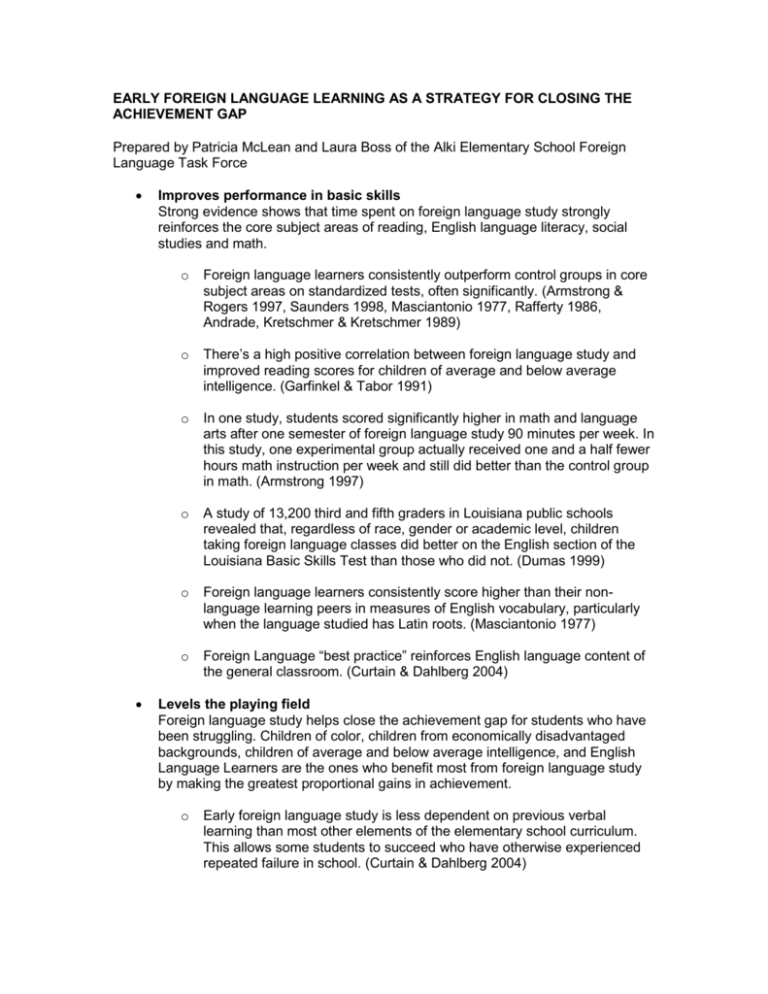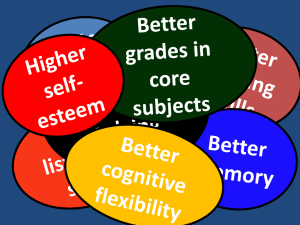Strategy for Closing the Achievement Gap
advertisement

EARLY FOREIGN LANGUAGE LEARNING AS A STRATEGY FOR CLOSING THE ACHIEVEMENT GAP Prepared by Patricia McLean and Laura Boss of the Alki Elementary School Foreign Language Task Force Improves performance in basic skills Strong evidence shows that time spent on foreign language study strongly reinforces the core subject areas of reading, English language literacy, social studies and math. o Foreign language learners consistently outperform control groups in core subject areas on standardized tests, often significantly. (Armstrong & Rogers 1997, Saunders 1998, Masciantonio 1977, Rafferty 1986, Andrade, Kretschmer & Kretschmer 1989) o There’s a high positive correlation between foreign language study and improved reading scores for children of average and below average intelligence. (Garfinkel & Tabor 1991) o In one study, students scored significantly higher in math and language arts after one semester of foreign language study 90 minutes per week. In this study, one experimental group actually received one and a half fewer hours math instruction per week and still did better than the control group in math. (Armstrong 1997) o A study of 13,200 third and fifth graders in Louisiana public schools revealed that, regardless of race, gender or academic level, children taking foreign language classes did better on the English section of the Louisiana Basic Skills Test than those who did not. (Dumas 1999) o Foreign language learners consistently score higher than their nonlanguage learning peers in measures of English vocabulary, particularly when the language studied has Latin roots. (Masciantonio 1977) o Foreign Language “best practice” reinforces English language content of the general classroom. (Curtain & Dahlberg 2004) Levels the playing field Foreign language study helps close the achievement gap for students who have been struggling. Children of color, children from economically disadvantaged backgrounds, children of average and below average intelligence, and English Language Learners are the ones who benefit most from foreign language study by making the greatest proportional gains in achievement. o Early foreign language study is less dependent on previous verbal learning than most other elements of the elementary school curriculum. This allows some students to succeed who have otherwise experienced repeated failure in school. (Curtain & Dahlberg 2004) o Teachers of foreign language hold the same high expectations for all of their students, as they have no preconceived idea of the skills and talents of individual students. o A Purdue University study demonstrates “a significant correlation between improved reading scores of children of average intelligence and taking a full year or two of foreign language.” (While reading scores improved for children of above average intelligence, the amount was statistically insignificant.) It is the average children who have the most to gain from foreign language study since, according to the authors, “…extended foreign language study gives students of average intelligence a kind of enrichment they may not be getting from other studies or experiences.” Foreign language study can help to alter the trajectory for these children and narrow the achievement gap. (Garfinkel & Tabor 1991) o Cincinnati’s Foreign Language Magnet Program has a student population that is 57% African American and 43% Caucasian, with 52% of the total receiving free and reduced lunch. Achievement for these children far exceeds national norms in both reading and math and participants in the foreign language magnet program on average score higher than the average of all Cincinnati’s many magnet programs. (Andrade, Kretschmer & Kretschmer 1989) o In a four year study by McGill University, working class students did just as well in foreign language as middle-class students even though their English skills were not as good. (Holobow 1988) Promotes cultural competency In an age of global interdependence and an increasingly multicultural and multiethnic society, early foreign language study gives children unique insight into other cultures and builds their cultural competency skills in a way that no other discipline is able to do. o “The age of ten is a crucial time in the development of attitudes toward nations and groups perceived as ‘other’ according to the research of Piaget, Lambert and others. At age 10, children are in the process of moving from egocentricity to reciprocity and information received before age 10 is eagerly received.” (Curtain & Dahlberg 2004) o “… exposure to a foreign language serves as a means of helping children to intercultural competence. The awareness of a global community can be enhanced when children have the opportunity to experience involvement with another culture through a foreign language.” (Curtain & Dahlberg 2004) o Foreign language learners are more tolerant of the differences among people. (Carpenter & Torney 1974) o “The positive impact of cultural information is significantly enhanced when that information is experienced through foreign language and accompanied by experiences in culturally authentic situations.” (Curtain & Dahlberg 2004) o Linguistic and cultural competence will be the mark of a well-educated citizen of the 21st Century (Cloud & Genesee 1998) Enriches and enhances cognitive development Recent brain research has shown that early language study results in substantial and long-lived benefits to the developing brain. o Research suggests that foreign language study “enhances children’s understanding of how language itself works and their ability to manipulate language in the service of thinking and problem solving.” (Cummins 1981) o Language learners show greater cognitive flexibility, better problem solving and higher order thinking skills (Hakuta 1986) o People who are competent in more than one language consistently outscore monolinguals on tests of verbal and nonverbal intelligence. (Bruck, Lambert, Tucker 1974, Hakuta 1986, Weatherford 1986) o Early language study results in greater skills in divergent thinking and figural creativity. (Landry 1973) o Foreign language learners have better listening skills and sharper memories than their monolingual peers. (Lapkin, et al 1990, Ratte 1968, ) o “The learning experiences of a child determine which [neural] connections are developed and which no longer function. That means what is easy and natural for a child – learning a language – can become hard work for an older learner.” (Curtain & Dahlberg 2004) o “The power to learn a language is so great in the young child that it doesn’t seem to matter how many languages you seem to throw their way…They can learn as many spoken languages as you can allow them to hear systematically and regularly at the same time. Children just have this capacity. Their brain is ripe to do this…there doesn’t seem to be any detriment to…develop[ing] several languages at the same time” according to Dr. Susan Curtiss, UCLA Linguistics professor. (Curtain & Dahlberg 2004) Enhances self-concept and sense of achievement in school Foreign language study is area where children not accustomed to achievement in school are able to excel. The resulting benefit to self-image, self-esteem and satisfaction with school experience are enormous. o Evidence from several studies study show language students to have a significantly higher self-concept than do non-language students. (Masciantonio 1977, Saunders 1998, Andrade, et al. 1989 ) o Language study is an area in which ELL students can be successful in front of their peers, since bilingual children learn additional languages more quickly and efficiently than monolingual children. (Cummins 1990) Offering foreign language study demonstrates to ELL students and their families that languages other than English - and by extension cultures other than the mainstream - are valued. REFERENCES Andrade, C., Richard R. Kretschmer Jr., and Laura W. Kretschmer (1989) Two Languages For All Children: Expanding To Low Achievers And The Handicapped. In K.E. Muller (ed.), Languages in the Elementary Schools, pp. 177-203. Armstong, P.W. and J.D. Rogers. (1997). Basic Skills Revisited: The Effects of Foreign Language Instruction on Reading, Math and Language Arts.” Learning Languages, Spring. 20-31. Bruck, Margaret, Wallace E. Lambert & Richard Tucker (1974) Bilingual Schooling through the Elementary Grades: the St. Lambert Project at Grade Seven. Language Learning 24, no. 2:183-204. Carpenter, John A. and Judith V. Torney. (1974) Beyond the Melting Pot. In Childhood and Intercultural Education: Overview and Research, edited by Patricia Maloney Markun. Washington DC: Association for Childhood Education International. Cloud, Nancy and Fred Genesee. (1998) Multilingualism Is Basic. Educational Leadership 55, no. 6 (March): 62-65. Cummins, James. (1981). The Role of Primary Language Development in Promoting Educational Success for Language Minority Students. In Schooling and Language Minority Students: A Theoretical Framework. Los Angeles: Evaluation, Dissemination, and Assessment Center, California State University. Curtain, Helena and Carol Ann Dahlberg. (2004) Languages and Children: Making the Match: New Languages for Young Learners, Grades K-8. Third Edition. New York: Longman. Dumas, L.S. (1999) Learning a Second Language: Exposing Your Child to a new World of Words Boosts Her Brainpower, Vocabulary & Self-Esteem. Child, February 72, 74. 76-77. Garfinkel, A. & Tabor, K.E. (1991) Elementary School Foreign Languages and English Reading Achievement: A New View of the Relationship. Foreign Language Annals, 24, No.5, 375 - 382. Hakuta, Kenjii. (1986) Cognitive Development of Bilingual Children. Los Angeles: University of California Center for Language Education and Research. ERIC Digest EDRS ED 278 260. Holobow, Naomi, Fred Genesee, Wallace E. Lambert, and Louis Chartrand. (1988) The Effectiveness of a Partial Immersion French Program for Students from Different Ethnic and Social Class Backgrounds. Montreal: McGill University, Department of Psychology. Lambert, Wallace E. and Otto Kleinberg. (1967) Children’s Views of Foreign People. New York: Appleton-Century-Crofts. Landry, Richard G. (1973) The Enhancement of Figural Creativity through Second Language Learning at the Elementary School Level. Foreign Language Annals 7, no.1 (October):111-115. Lapkin, Sharon, Merrill Swain, and Stanley M. Shapson. (1990) French Immersion Agenda for the 90s. Canadian Modern Language Review 46, 638-674. Masciantonio, R. (1977) Tangible Benefits of the Study of Latin: A Review of Research. Foreign Language Annals, 10, 375-382. Nash, J. Madeline. (1997) Fertile Minds. Time February 3, 49 – 56. Rafferty, Eileen A. (1986) Second Language Study and Basic Skills in Louisiana, 80-85. Baton Rouge: Louisiana Department of Education. Ratte, EH. (1968) Foreign Language and the Elementary School Language Arts Program. The French Review 42. Saunders, C.M. (1998) The Effect of the Study of a Foreign Language in the Elementary School on Scores on the Iowa Test of Basic Skills and an Analysis of Studentparticipant Attitudes and Abilities. Unpublished Dissertation, University of Georgia. Weatherford, H. Jerold. (1986) Personal Benefits from Foreign Language Study. Washington , DC: ERIC Clearinghouse on Languages and Linguistics. ERIC Digest, EDRS 276 305.






